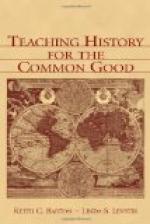9. Let the questions
from day to day develop the continuity of
history.
Avoid questioning that fails to unite the events of
previous
lessons with the one being studied. Bring out
the
connection
of the past and the present. Slavery existed in
America
for two hundred years before the Civil War was fought.
Your
teaching of those two centuries of history should be
so
conducted
that when the Civil War is finally reached, the class
can
tell the process by which anti-slavery sentiment was
finally
crystallized.
The hiatus between the mobbing of Garrison in
Boston
and the extraordinary contribution of Massachusetts
to
the
Northern army should be bridged, not by a heroic question
or
two
when the war is finally reached, but by a daily attention
to
the
events which effected the metamorphosis.
10. If the answer to
your question requires the use of a map, ask
it
in such a way that the student can talk and use the
map at
the
same time. The geographical provisions of a treaty,
the
routes
of explorers, the grants of commercial companies,
campaigns,
or military frontiers should all be recited in this
way.
A wall map with simply the outline of the territory,
with
its
rivers, will be of considerable assistance in testing
the
accuracy
of the student’s geographical knowledge.
While
reciting,
let him locate with chalk or pointer the cities,
arbitrary
boundary lines, and routes he finds it necessary to
mention
in his recitation. It will require special attention
early
in the course to teach students the necessity for
preparation
of this sort. Like everything else, map work should
be
reasonable in its requirements. A knowledge of
geography is
imperative
to the correct understanding of history, and the
indifference
or ignorance of teachers should never excuse
inattention
to this vital necessity. On the other hand, however,
it
is equally reprehensible to require of high school
students
the
labored preparation of maps in the drawing of which
hours of
valuable
time are spent in searching for places of trivial
importance
and small historical value. Map work in a high
school
history
course should require no more than geographical accuracy
in
locating boundaries, routes, and places really vital
to the
history
of the people being studied. If it does more than
this
it
usurps time disproportionate to its value.
V
VARIOUS MODES OF REVIEW
The place of drill in the history recitation
We have long since learned the folly of spending very many of the minutes of a recitation in drilling students in dates, outlines, and charts. Work of this sort never made a recitation vital; never inspired a student with enthusiasm for historical inquiry; never really dispelled the fog which surrounds, for the student, the cabinets and constitutions, battles and boundaries, declarations and decrees, so briefly treated in the text.




